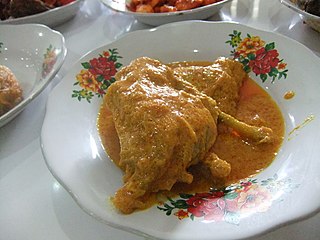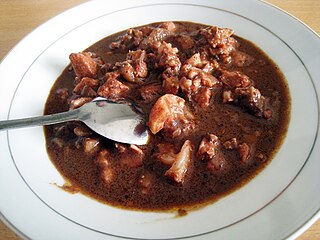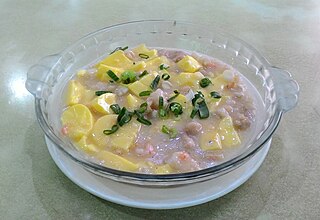
Satay, or sate in Indonesian and Malay spelling, is a Southeast Asian dish of seasoned, skewered and grilled meat, served with a sauce. It is from Indonesia and popular in Malaysia, Philippines, Singapore, Thailand, and Brunei. It also recognized and popular along Suriname and Netherlands. Satay may consist of diced or sliced chicken, goat, mutton, beef, pork, fish, other meats, or tofu; the more authentic version uses skewers from the midrib of the coconut palm frond, although bamboo skewers are often used. These are grilled or barbecued over a wood or charcoal fire, then served with various spicy seasonings. Satay can be served in various sauces, however most often they are served in a combination of soy and peanut sauce. Hence, peanut sauce is often called satay sauce.

Indonesian cuisine is a collection of various regional culinary traditions that formed the archipelagic nation of Indonesia. There are a wide variety of recipes and cuisines in part because Indonesia is composed of approximately 6,000 populated islands of the total 17,508 in the world's largest archipelago, with more than 300 ethnic groups calling Indonesia home. Many regional cuisines exist, often based upon indigenous culture with some foreign influences. Indonesia has around 5,350 traditional recipes, with 30 of them considered the most important. Indonesia's cuisine may include rice, noodle and soup dishes in modest local eateries to street-side snacks and top-dollar plates.

Egg foo young is an omelette dish found in Chinese Indonesian, British Chinese, and Chinese American cuisine. The name comes from the Cantonese language. Egg foo young is derived from fu yung egg slices, a mainland Chinese recipe from Guangdong.

Chinese Indonesian cuisine is characterized by the mixture of Chinese with local Indonesian style. Chinese Indonesians brought their legacy of Chinese cuisine, and modified some of the dishes with the addition of Indonesian ingredients, such as kecap manis, palm sugar, peanut sauce, chili, santan and local spices to form a hybrid Chinese-Indonesian cuisine. Some of the dishes and cakes share the same style as in Malaysia and Singapore which are known as the Nonya cuisine by the Peranakan.

Babi panggang refers to a variety of recipes for Indonesian grilled pork recipes, 'babi' meaning pig or pork, and 'panggang' meaning grilled or roasted in the Indonesian language.

Gulai ayam is a traditional Indonesian dish of chicken cooked in a spicy, rich, yellowish, curry-like sauce called gulai. It is originally from West Sumatra (Padang). It can be classified as an Indonesian curry. Together with gulai kambing,, it is the most common and popular variant of gulai.

Saksang or sa-sang is a savory, spicy Indonesian dish from the Batak people. It is made from minced pork or dog meat stewed in its blood, coconut milk and spices; including kaffir lime and bay leaves, coriander, shallot, garlic, chili pepper and Thai pepper, lemongrass, ginger, galangal, turmeric and andaliman.
Sambal Tuktuk is the typical traditional hot and spicy condiments commonly served in Batak cuisine of Batak people, native of Tapanuli region, North Sumatra, Indonesia.

Balinese cuisine is a cuisine tradition of Balinese people from the volcanic island of Bali. Using a variety of spices, blended with the fresh vegetables, meat and fish. Part of Indonesian cuisine, it demonstrates indigenous traditions, as well as influences from other Indonesian regional cuisine, Chinese and Indian. The island's inhabitants are predominantly Hindu and culinary traditions are somewhat distinct with the rest of Indonesia, with festivals and religious celebrations including many special foods prepared as the offerings for the deities, as well as other dishes consumed communally during the celebrations.

Batak cuisine is the cuisine and cooking traditions of Batak ethnic groups, predominantly found in North Sumatra region, Indonesia. Batak cuisine is part of Indonesian cuisine, and compared to other Sumatran cuisine traditions, it is more indigenously preserved. One characteristic of Batak cuisine is its preference to andaliman as the main spice. That is why andaliman in Indonesia sometimes dubbed as "Batak pepper".
Manuk is an uninhabited volcanic island located in the Banda Sea, Indonesia.

Manado cuisine or Minahasan cuisine is the cooking tradition of the Minahasan people of North Sulawesi, Indonesia. It is popularly known as "Manadonese cuisine" after Manado, the capital of the province, although other cities in North Sulawesi, such as Bitung, Tomohon and Tondano, are also known as Minahasan culinary hotspots. Manadonese cuisine is known for its rich variations in seafood, generous amount of spices, extra-hot condiments, exotic meats, and European-influenced cakes and pastries. Popular Manadonese dishes include tinutuan, cakalang fufu, cakalang noodle, paniki, chicken or various fish and seafood spiced in rica-rica or woku spices, chicken tuturuga, and brenebon.
![Sweet soy sauce Sweetened aromatic [https://commons.wikimedia.org/wiki/File:Salsa_soja_dulce.png soy sauce], originating from Indonesia](https://upload.wikimedia.org/wikipedia/commons/thumb/8/89/Kecap.jpg/213px-Kecap.jpg)
Sweet soy sauce is a sweetened aromatic soy sauce, originating in Indonesia, which has a darker color, a viscous syrupy consistency and a molasses-like flavor due to the generous addition of palm sugar. Kecap manis is widely used with satay. It is similar to, though finer in flavor than, Chinese sweet bean sauce (tianmianjiang). It is by far, the most popular type of soy sauce employed in Indonesian cuisine, accounts for an estimated 90 percent of the nation's total soy sauce production.

Babi kecap is an Indonesian braised pork with sweet soy sauce. It is a Chinese Indonesian classic, due to its simplicity and popularity among Chinese Indonesian households. It is also popular among non-Muslim Indonesians, such as the Balinese, Batak and Minahasan, and in the Netherlands, where it is known as babi ketjap, owing to colonial ties with Indonesia. In the Netherlands, the dish might also be served within an opulent rijsttafel banquet.

Balado is a type of hot and spicy bumbu found in Minang cuisine of West Sumatra, Indonesia. Balado sauce is made by stir frying ground red hot chili pepper with other spices including garlic, shallot, tomato and key lime juice in coconut or palm oil.

Mun tahu is Chinese Indonesian dish of soft tofu braised in savoury thick white sauce, mixed with minced chicken and shrimp.

Acehnese cuisine is the cuisine of the Acehnese people of Aceh in Sumatra, Indonesia. This cuisine is popular and widely known in Indonesia. Arab, Persian, and Indian traders influenced food in Aceh although flavours have changed a lot their original forms. Combination of spices in Acehnese cuisine just as are commonly found in Indian and Arab cuisine, such as ginger, pepper, coriander, cumin, cloves, cinnamon, cardamom and fennel. A variety of Acehnese food is cooked with curry and/or coconut milk, which is generally combined with meat such as buffalo, beef, mutton, fish, or chicken.

Arab Indonesian cuisine is characterized by the mixture of Middle Eastern cuisine with local Indonesian-style. Arab Indonesians brought their legacy of Arab cuisine—originally from Hadhramaut, Hejaz and Egypt—and modified some of the dishes with the addition of Indonesian ingredients. The Arabs arrived in the Nusantara archipelago to trading and spread Islam. In Java, since the 18th century AD, most of Arab traders settled on the north coast and diffuse with indigenous, thus affecting the local cuisine culture, especially in the use of mutton meat and ghee in cooking.

Indian Indonesian cuisine is characterized by the mixture of Indian cuisine with local Indonesian-style. This cuisine consists of adaptations of authentic dishes from India, as well as original creations inspired by the diverse food culture of Indonesia. Indian influence can be observed in Indonesia as early as the 4th century. Following the spread of Islam to Indonesia and trading, Muslim Indian as well as Arab influences made their way into Indonesian cuisine. Examples include Indian biryani, murtabak, curry and paratha that influenced Acehnese, Minangkabau, Malay, Palembangese, Betawi and Javanese cuisine.

Madurese cuisine is a cuisine tradition of Madurese people from Madura Island in Indonesia. This cuisine also known in East Java as well as on the south coast of Kalimantan. Madura cuisine has salty, savoury and spicy tastes with Javanese-influenced.









![Sweet soy sauce Sweetened aromatic [https://commons.wikimedia.org/wiki/File:Salsa_soja_dulce.png soy sauce], originating from Indonesia](https://upload.wikimedia.org/wikipedia/commons/thumb/8/89/Kecap.jpg/213px-Kecap.jpg)






